Guest post by Kaja Šeruga.
In this article, I will explain how MAXQDA can help you analyze texts using the documentary method, without delving too much into the methodological underpinnings of the process. If you would like to learn more about the method itself, I have listed further sources for you at the end of this article.
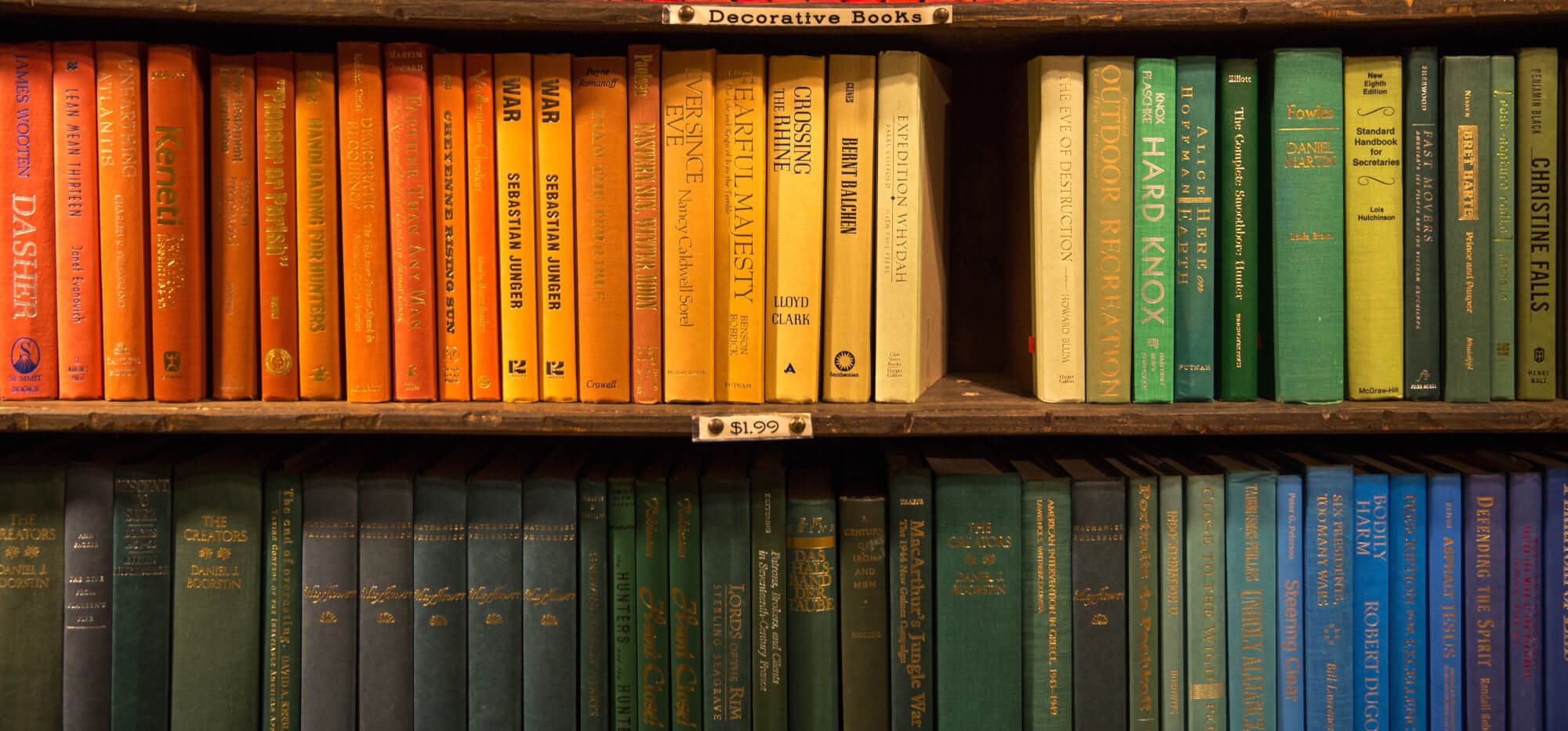
We can probably all remember that moment during our first research project when, having dutifully waded through the theory, decided on a methodology, and bravely entered the field to collect our data, we suddenly realize that the work is only just beginning, and there are simply not enough highlighters in the world to make sense of it.
That was me about a year ago, wrestling with the interviews that made up the core of my overambitious master’s thesis research on the topic of immigration phobia in Slovenia and Germany in the context of the European refugee crisis. Following the advice of my supervisor, I had decided to analyze the interviews using the documentary method, an approach developed by Ralf Bohnsack in the 1980s. This method is rooted in the change of focus from “what” is being communicated to “how” it is being communicated.
The good is news: the documentary method offers the researcher a systematic way of slipping beneath the surface of a text and exploring its inner logic, reconstructing the conjunctive knowledge underlying people’s narratives and actions. Now for the bad news: this method of analysis can be very cumbersome, producing dozens, if not hundreds, of pages of interrelated texts which can be very difficult to keep track of.
Luckily, the versatility of MAXQDA’s tools means that, with some creative thinking, you can assemble a useful toolbox for pretty much any type of analysis, integrating your process into one MAXQDA project. While you will still have to do the heavy lifting of interpretation and type-building, MAXQDA makes the process faster and easier. You can organize and back up your work, as well as retrieve the relevant sections of your analysis at the click of a button.
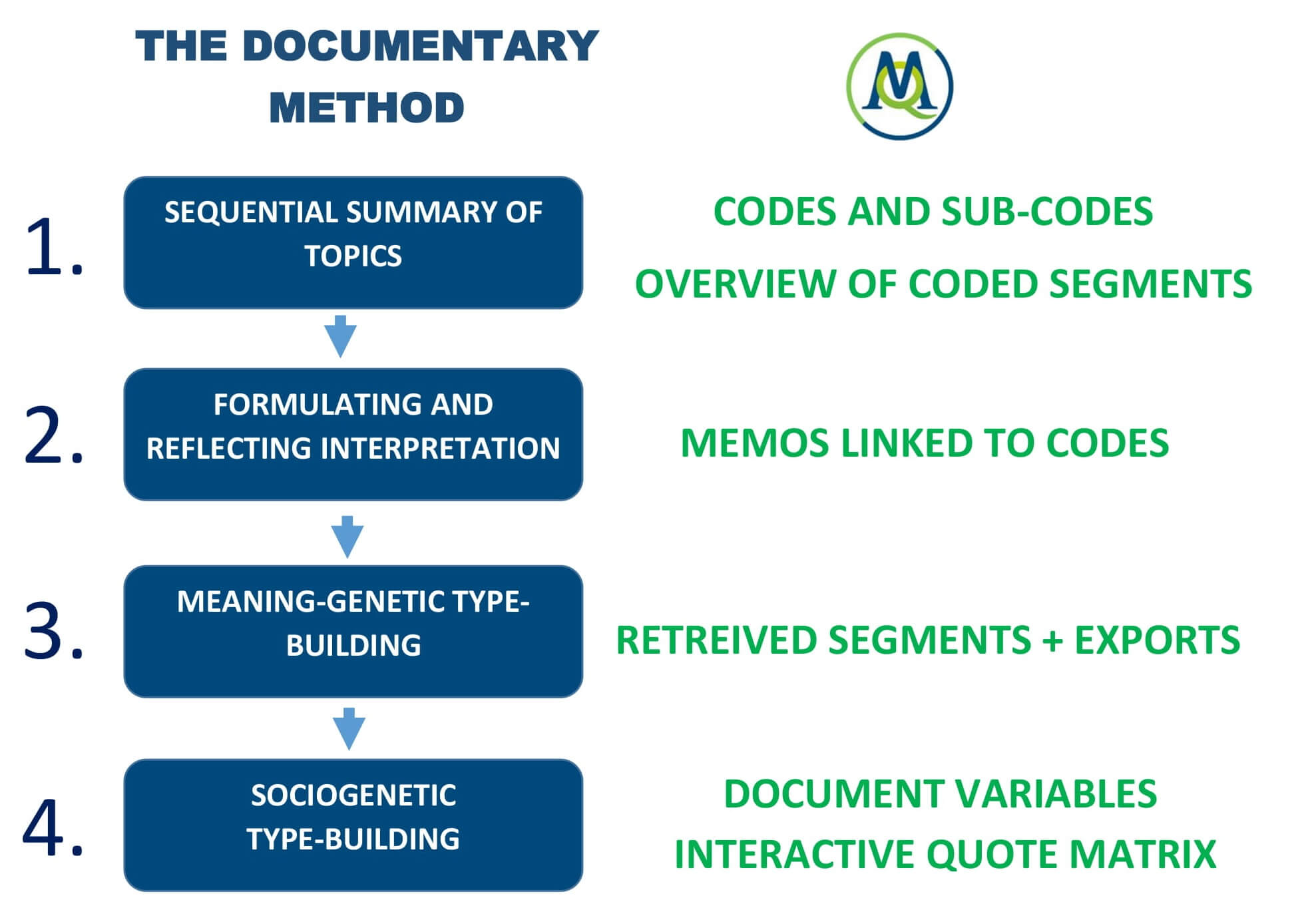
Note: Because the data used in my research is confidential, the project screenshots in this article were created using the “Life Satisfaction” example project included in MAXQDA, which you can also use to try out the various features and functions described below.
1. Transcription and Summary of Topics
Using the documentary method, the researcher only analyses relevant themes, rather than entire interviews. These themes are determined by the research question, but also by the interview partners themselves since it’s fair to assume that any topic which elicits an especially eloquent and nuanced narrative is in some way important to that person. Finally, only themes that are addressed in different interviews can become relevant, so that a comparative analysis of the frame of orientation is possible.
In order to identify relevant themes, the researcher must first write a sequential summary of topics for each interview. This process will be a bit different depending on whether you have already transcribed your interviews, or if you will be transcribing them in MAXQDA.
1.1. Coding imported transcripts to create a sequential summary of topics
If your interviews have already been transcribed, the use of codes will help you identify the recurring themes in your interviews. Use codes and subcodes to mark the themes and subthemes that emerge in the interview, arranging the codes hierarchically to reflect their relation to each other.
Once you have finished coding, you may wish to see all your themes in a list. Right-click the document and select the Overview of Coded Segments. You can arrange it chronologically by clicking on the Begin (or Beginning) column header. This list can then be exported into a separate file for comparison with other interviews.
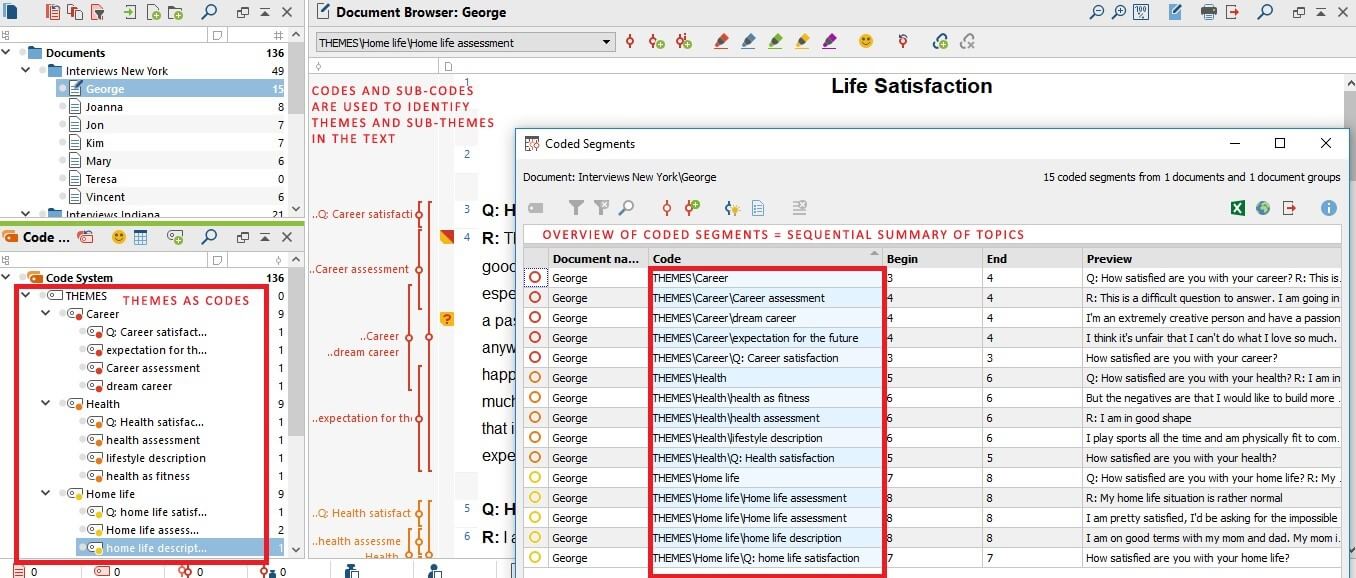
1.2. Transcribing with MAXQDA
A big advantage of transcribing the interviews directly in MAXQDA is that the software links your transcript with the relevant sections of the audio recording via timestamps. Timestamps can later be especially useful for reflecting on your interpretations because listening to the audio can help glean meaning that may have been lost during the transcription process.
Since the focus of the documentary method is on forming types from multiple cases through comparison, not on the detailed analysis of each case individually, there is no need to transcribe interviews in their entirety.
To compile the sequential summary of topics for each interview, simply listen to the audio recording in MAXQDA’s Multimedia Browser and write down the themes that emerge in a sequential order. Use the Enter key to create new timestamps.
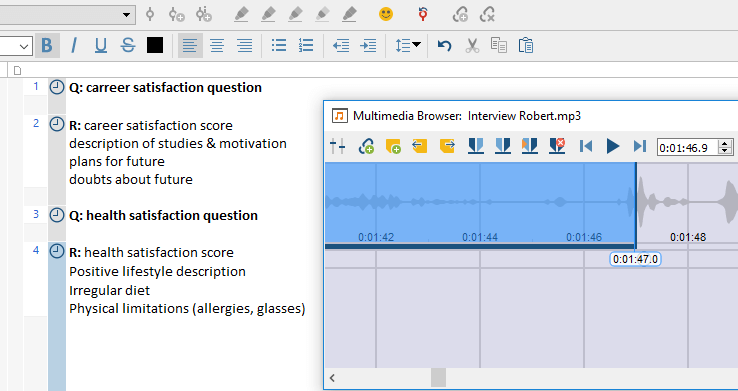
After you have added timestamps for all your interviews and found the themes that you want to explore in your analysis, you can then transcribe the relevant parts. Click the timestamp next to the summary you wrote down and write the full transcription of that section.
Tip: If you want to keep this summary of topics for later reference, make sure to export the document before making changes to it.
Once your transcription is finished, mark the relevant themes by coding them (as described in section 1.1) to prepare for the next step of analysis.
2. Using Memos for Formulating and Reflecting Interpretations
Both the formulating and the reflecting interpretation – the former referring to what is being said and the latter to how it is being said – are carried out using memos.
Create a memo for the relevant part of your transcript and write your interpretation into the text box. A couple of things to keep in mind that will make your work easier afterward:
- It is crucial that you manually link your memos to the relevant theme using the Link to code function.
- Decide which memo type you will assign to the different stages of interpretation. I like to use the red-cornered memos for the formulating and the blue-cornered ones for the reflecting interpretations, so the memos are visually distinct even when closed.
- Use the Type label function to further clarify which step of interpretation different memo types are associated with. You only have to write down the type label once – after that MAXQDA will automatically associate that label with the icon you chose.
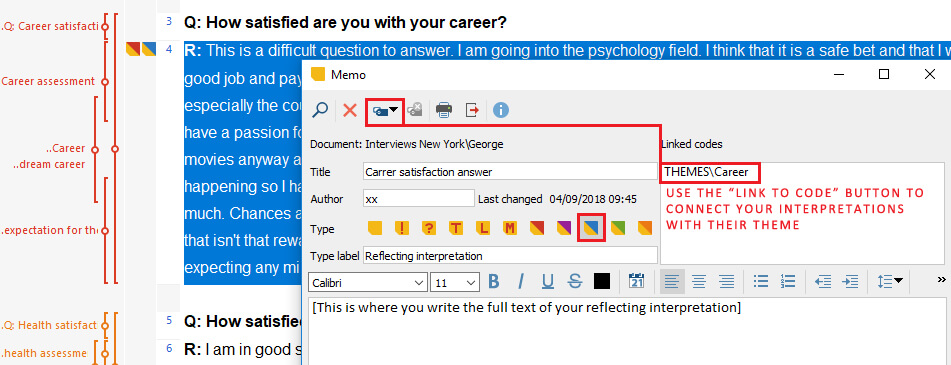
3. Use the “Retrieved Segments” Window to Simplify Meaning-Genetic Type Formation
The first level of type formation in the documentary method is meaning-genetic type formation. This refers to the abstraction, or general principle, of the shared frames of orientation found across multiple interviews.
This step can be made much easier by activating your documents and the theme (code) that you want to work with. The “Retrieved Segments” window will show you the interview passages associated with the theme, as well as the memos connected to it (hovering your mouse cursor over the memo icon will show you some of its content).
Next, click Export in the “Retrieved Segments” window to create a document that brings together all the interview passages connected to a theme, as well as all the interpretations associated with each passage.
In the Export coded segments window that pops up, make sure to select Memos under Further information so they appear in the final document.
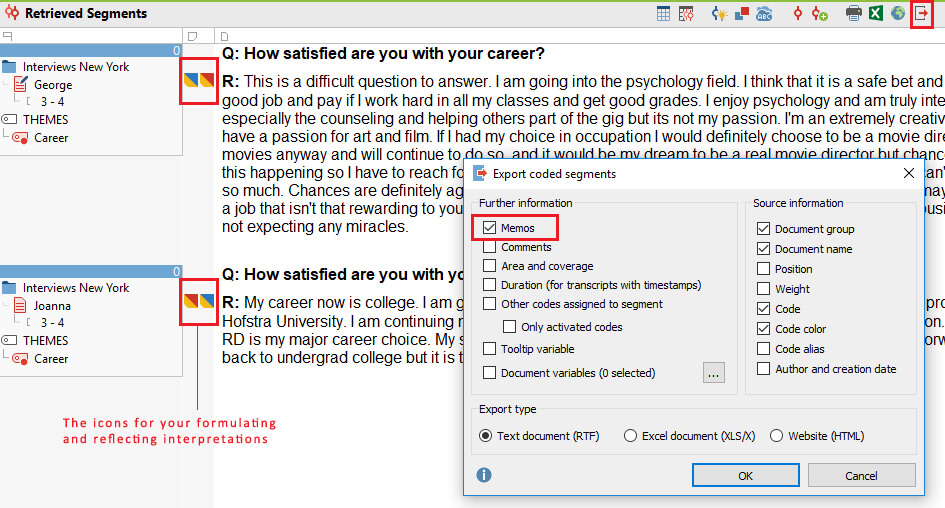
4. Use Variables and the Interactive Quote Matrix to Simplify Sociogenetic Type Formation
If you are also interested in sociogenetic typification – i.e. associating certain frames of orientation with sociodemographic characteristics – you can save a lot of time by assigning sociodemographic data to your documents in the form of variables. That way you can simply compare and contrast the passages within a certain theme by using the Interactive Quote Matrix, which will display the quotes within the theme, as well as any memos associated with it.
In the figure below, I am comparing the responses of my male and female respondents on the topic of “career”, in order to see how their frames of orientation might differ.
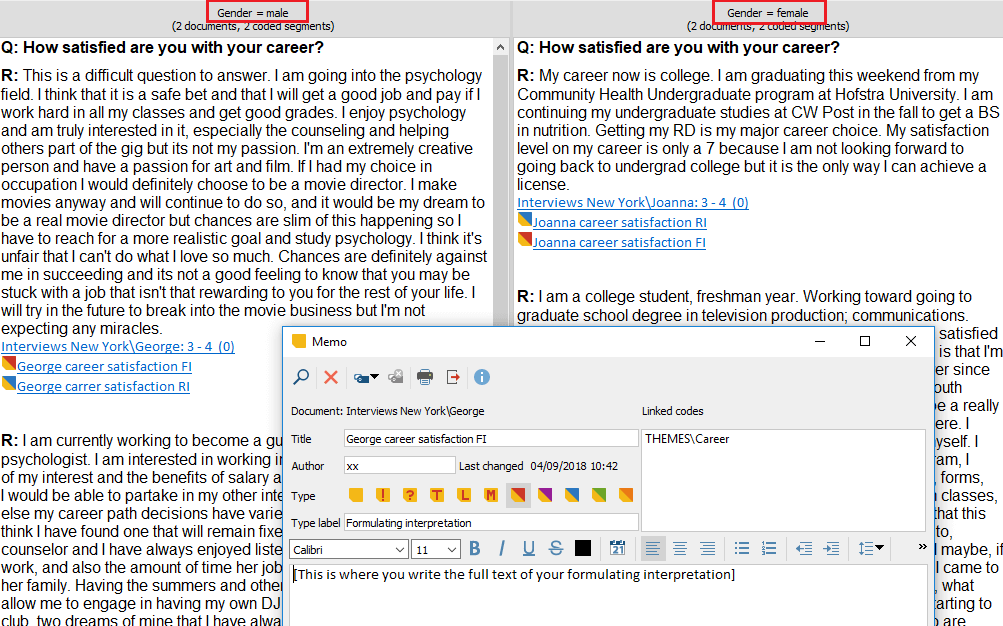
The only downside of this approach is that the exported document will not include your interpretations (memos), but you can open them in the matrix itself. Alternatively, you can activate, for example, all documents with the “male” variable (using the Activate by Document Variables function) and the relevant theme, allowing you to bring together the responses of all your male respondents on a certain topic in the “Retrieved Segments” window. In this case, you can export these responses together with the interpretations you associated with it (as shown in step 3).
5. Tip: Re-import Exported Documents into MAXQDA for Safekeeping
In the course of your documentary method analysis, you will produce a number of new documents by exporting your data in various configurations. While you can store these documents in a folder structure of your choice, I would highly recommend re-importing them into your MAXQDA project.
By re-importing your documents, you can quickly find them in the “Document System” and, more importantly, they will be bundled up into a neat MAXQDA file together with all your other data, making it easy to back up often and in multiple locations. This way, even if you lose the original file you can still see and re-export it from MAXQDA.
Conclusion
Once you’ve made it through all the stages of documentary method analysis and are ready to write up your results, you will mostly be relying on your interpretations and typologies. However, MAXQDA also simplifies this final stage of research by making it easy to call up any interesting quotes that you might want to use to illustrate your point, as well as creating clear visual displays of your data for presentations.
The documentary method is a time-intensive approach that requires the researcher to deeply engage with the data on multiple levels. Using MAXQDA to streamline the working process eliminated a lot of unnecessary stress and allowed me to spend my time focusing on the actual work of interpretation of analysis, without having to trawl through dozens of pages of text in order to unearth a handful of relevant passages.
Hopefully this article also gave you some useful ideas on how to simplify your analysis process, using the documentary method or otherwise.
Further resources on the documentary method of analysis:
English:
German:
About the Author
Kaja Šeruga recently obtained her master’s degree from the Humboldt University in Berlin. As part of the Global Studies Programme she studied at HU Berlin, FLACSO Argentina and JNU Delhi, focusing on various aspects of migration and displacement. Her final research project was conducted on the topic of immigration phobia in Slovenia and Germany.
She is an alumna of the Brown International Advanced Research Institute (BIARI) on the topic of Forced Population Displacements and the Making of the Modern World and co-authored a chapter in “The Disaster of European Refugee Policy: Perspectives from the Balkan route” (Cambridge Scholars Publishing).

 Kaja Šeruga recently obtained her master’s degree from the Humboldt University in Berlin. As part of the Global Studies Programme she studied at HU Berlin, FLACSO Argentina and JNU Delhi, focusing on various aspects of migration and displacement. Her final research project was conducted on the topic of immigration phobia in Slovenia and Germany.
Kaja Šeruga recently obtained her master’s degree from the Humboldt University in Berlin. As part of the Global Studies Programme she studied at HU Berlin, FLACSO Argentina and JNU Delhi, focusing on various aspects of migration and displacement. Her final research project was conducted on the topic of immigration phobia in Slovenia and Germany.


